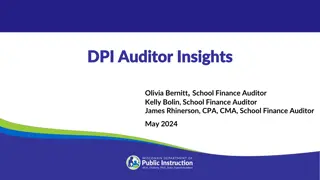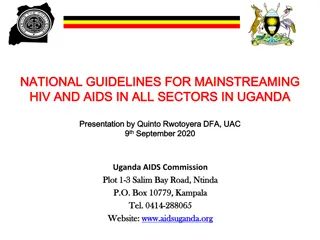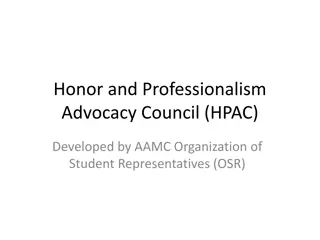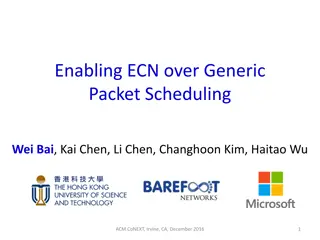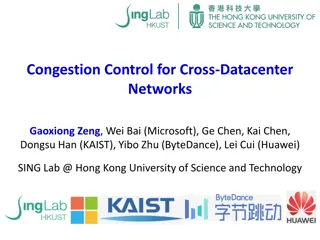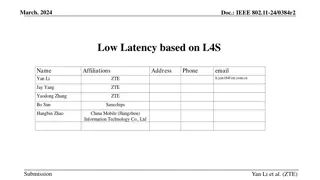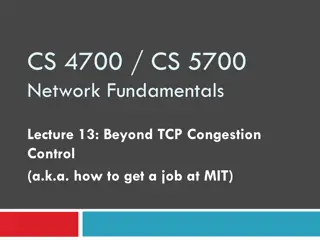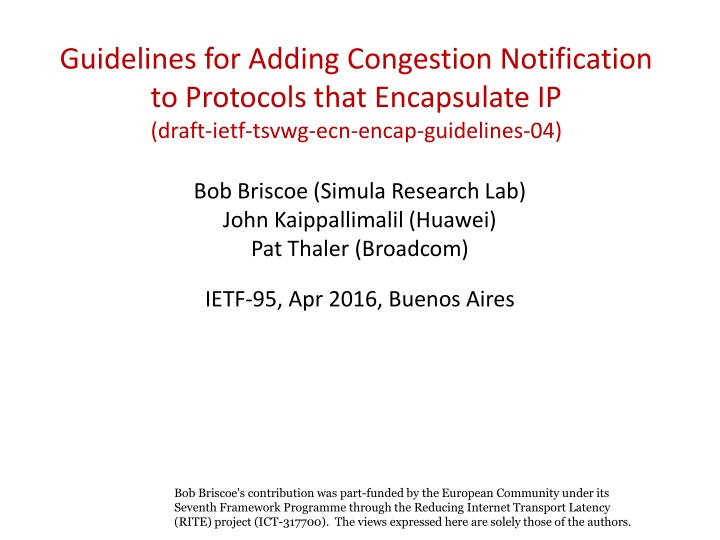
Adding Congestion Notification Guidelines to IP Encapsulation Protocols
Learn about the guidelines for adding congestion notification to protocols encapsulating IP, as presented in the draft by Bob Briscoe, John Kaippallimalil, and Pat Thaler. Explore the need for standardization across layers and recent activities involving 3GPP liaisons and potential ECN layering issues.
Download Presentation

Please find below an Image/Link to download the presentation.
The content on the website is provided AS IS for your information and personal use only. It may not be sold, licensed, or shared on other websites without obtaining consent from the author. If you encounter any issues during the download, it is possible that the publisher has removed the file from their server.
You are allowed to download the files provided on this website for personal or commercial use, subject to the condition that they are used lawfully. All files are the property of their respective owners.
The content on the website is provided AS IS for your information and personal use only. It may not be sold, licensed, or shared on other websites without obtaining consent from the author.
E N D
Presentation Transcript
Guidelines for Adding Congestion Notification to Protocols that Encapsulate IP (draft-ietf-tsvwg-ecn-encap-guidelines-04) Bob Briscoe (Simula Research Lab) John Kaippallimalil (Huawei) Pat Thaler (Broadcom) IETF-95, Apr 2016, Buenos Aires Bob Briscoe's contribution was part-funded by the European Community under its Seventh Framework Programme through the Reducing Internet Transport Latency (RITE) project (ICT-317700). The views expressed here are solely those of the authors.
recap draft-ietf-tsvwg-ecn-encap-guidelines-04 Purpose of this draft: Guidelines on standardisation of protocols and systems to ensure ECN is correctly deployed cross-layer Purpose of recent liaisons: catch systemic ECN layering problems: IEEE: https://datatracker.ietf.org/liaison/1364/ 3GPP: https://datatracker.ietf.org/liaison/1424/
Recent activity 3GPP response to IETF/tsvwg liaison identified 6 3GPP WGs that could be affected by ECN layering SA2, SA4, RAN2, CT1, CT3, CT4 20 3GPP tech specs with normative refs or normative text relying on IETF RFC3168 We read them all Draft response prepared Designing ECN support in TRILL (see later) Appropriate updates to draft-ietf-ecn-encap-guidelines-05 discussion on how to normatively update numerous tunnel specs SA Service & System Aspects RAN Radio Access Network CT Core Network & Terminals
3GPP Liaison: Context IP-a APN #1 PDCP-a GTP-a2 GTP-a1 (e.g., IMS Network) IP-b PDCP-b GTP-b2 GTP-b1 APN #2 (e.g., internet) Application IP IP Relay Relay PDCP GTP-U GTP-U GTP-U PDCP GTP-U RLC RLC UDP/IP UDP/IP UDP/IP UDP/IP MAC L2 L2 L2 L2 MAC L1 L1 L1 L1 L1 L1 LTE-Uu S1-U S5/S8 SGi UE eNodeB Serving GW PDN GW ECN mark set on radio congestion, used to trigger rate adaptation Lower layer transport (MPLS, Ethernet) carrying GTP and IP packet Snippets from liaison statement to 3GPP .. However, ECN is now being used in a number of environments including coder selection and rate adaptation, where 3GPP protocols such as PDCP encapsulate IP. As active queue management (AQM) and ECN become widely deployed in 3GPP networks and interconnected IP networks, it could be incompatible with the standardized use of ECN across the end-to-end IP transport [draft-ietf-aqm-recommendation]. The IETF is now considering new uses of ECN for low latency [draft-welzl-ecn-benefits] that would be applicable to 5G mobile flows. However, the IETF has realized that it has given little if any guidance on how to add explicit congestion notification to lower layer protocols or interfaces between lower layers and ECN in IP.
3GPP references to ECN bold: LS says normative ECN text italic: I found normative ECN text 3GPP TSG SA WG2 23.228 IMS 23.060 GPRS 23.401 GPRS for E- UTRAN 3GPP TSG SA WG4 26.114 IMS MM telephony; media handling & interaction 26.223 Telepresence using IMS [no ECN mention] 26.247 PS Streaming & 3GP-DASH [no ECN mention] 3GPP TSG CT WG1 3GPP TSG CT WG4 23.333 M-M Resource Function Controller (MRFC) - Processor (MRFP) Mp i/f 29.333 MRFC - MRFP Mp interface; Stage 3 23.334 IMS Application Level G/w (IMS-ALG) - IMS Access G/w (IMS- AGW) I/f 29.334 IMS-ALG - IMS- AGW; Iq Interface; Stage 3 29.238 Interconnection Border Control Summary: all except the Radio Access ones are fine primarily L4-7 and fully compatible with ECN-in-RTP [RFC6679]
ECN in 3GPP TS 25.401 & TS 36.300 Overall description UTRAN & E-UTRA, respectively 7.2.11 & 11.6 respectively: Explicit Congestion Notification The eNB shouldset the Congestion Experienced (CE) codepoint ( 11 ) in PDCP SDUs in the downlink direction to indicate downlink (radio) congestion if those PDCP SDUs have one of the two ECN-Capable Transport (ECT) codepoints set. The eNB should set the Congestion Experienced (CE) codepoint ( 11 ) in PDCP SDUs in the uplink direction to indicate uplink (radio) congestion if those PDCP SDUs have one of the two ECN-Capable Transport (ECT) codepoints set. This gives normative specification of base station behaviour UTRAN Universal Terrestrial Radio Access Network E-UTRA Evolved UTRA PDCP Packet Data Convergence Protocol SDU Service Data Unit 2 problems (next 2 slides): 1. PDCP layered below IP and has no ECN field of its own 2. marking behaviour unclear The liaison has highlighted difficulty understanding RFC3168 eNB evolved NodeB (base station)
#1 ECN layering problems in 3GPP TS 25.401 & TS 36.300 no specs of how the ECT codepoint got to the outer header at the PDCP GTP tunnel end-point specs need to refer to RFC6040 (bis?) Seems to solely apply to downlink eNB replaces IP-UDP-GTP header with RLC-PDCP which has no ECN field ECN codepoints in PDCP SDUs must mean ECN in the IP header inside ? Otherwise: how does eNB know a PDCP SDU has ECT codepoint set at the IP layer? how does PDCP propagate ECN to the IP header at the terminal? but the IP headers that PDCP encapsulates, may be compressed (RoHC) Application IP IP Relay Relay PDCP GTP-U GTP-U GTP-U PDCP GTP-U RLC RLC UDP/IP UDP/IP UDP/IP UDP/IP MAC L2 L2 L2 L2 MAC L1 L1 L1 L1 L1 L1 LTE-Uu S1-U S5/S8 SGi UE eNodeB Serving GW PDN GW
#2: ECN behaviour in 3GPP TS 25.401 & TS 36.300 Marking & response behaviour 3GPP needs to clarify: whether marking is confined to voice bearers (and why?) whether the wording implies all or nothing marking otherwise incompatibility between all-or-nothing and loss- equivalent [RFC3168] marking in other networks - Should codec rate reduction be triggered on a single CE mark? - Should codec rate reduction be triggered on multiple CE marks? 3GPP Network PCRF MME External Network S1-C Gx Router sets CE S5 Control P-GW S-GW S1-U S5 User eNB Downstream packet R R UE R Host R R R R R R No congestion in radio network R R R R TS 23.401 specifies some constraints on the marking behaviour, but I could not find a spec of the behaviour itself: To make sufficient time available for end-to-end codec rate adaptation the E-UTRAN/UTRAN should attempt to not drop any packets on a bearer for a default grace period of at least 500 ms after it has indicated congestion with ECN on the bearer for packets within the packet delay budget. During this ECN grace period the E-UTRAN/UTRAN should also attempt to meet the QCI characteristics / QoS class associated with the bearer. NOTE 1: Note that the receiving end-point should interpret all ECN-CE signals received within one end-to-end round-trip time as one "congestion event" (see IETF RFC 3168 [55] and TS 26.114 [56]).
ECN Support in TRILL A new technique for adding ECN support at a lower layer only if L2 protocol is well-designed for forward-compatibility (as TRILL is) to be added to list of ECN encap tricks in ecn-encap-guidelines draft TRILL has a facility to flag a critical extension that the egress must drop if it doesn't understand exploit this for congestion experienced flag legacy egress that does not understand how to propagate ECN drops the frame (desired outcome) New individual draft-eastlake-trill-ecn-support-00 but it currently does not cover this new idea see TRILL proceedings this week for design slideware
Updating Tunnel Specs ecn-encap-guidelines-05 includes following text: Therefore, in all such tightly coupled IP-in-IP tunnelling protocols the rules in [RFC6040] for propagating the ECN field between the two IP headers SHOULD be applied directly. Examples of tightly coupled IP-in-IP tunnelling protocols where [RFC6040] can be applied directly are: o L2TP [RFC2661] o GRE [RFC1701], [RFC2784] o PPTP [RFC2637] o GTP [GTPv1], [GTPv1-U], [GTPv2-C] {Note 1} o VXLAN [RFC7348]. Given the intent is to update all these Proposed Standards, how best to do this? a) rephrase ecn-encap-guidelines to update RFC6040 and all these RFCs b) new 1-page RFC6040bis Proposed Standard to extend scope to these RFCs {Note 1} GTP is a 3GPP protocol sandwiched within IP headers the IETF would specify ECN propagation across the IP headers 3GPP would refer to that in the GTP specs
Next Steps IETF response to 3GPP liaison response ecn-encap edits: RFC6040bis text (either in ecn-encap, or new draft) generalisation of new TRILL technique then WGLC ecn-encap-guidelines ?
Guidelines for Adding Congestion Notification to Protocols that Encapsulate IP (draft-ietf-tsvwg-ecn-encap-guidelines-04) Q&A Spare slide
#2: Ethernet Backhaul in 3GPP Networks IP-a APN #1 (e.g., IMS Network) PDCP-a GTP-a2 GTP-a1 IP-b PDCP-b GTP-b2 GTP-b1 APN #2 (e.g., internet) Application IP IP Relay Relay PDCP GTP-U GTP-U GTP-U PDCP GTP-U RLC RLC UDP/IP UDP/IP UDP/IP UDP/IP MAC L2 L2 L2 L2 MAC L1 L1 L1 L1 L1 L1 LTE-Uu S1-U S5/S8 SGi UE eNodeB Serving GW PDN GW Ethernet backhaul for S1 and S5 Expected behavior: - If congestion experienced, unlike in MPLS (feed-forward-and-up), the Ethernet backhaul network should set CE in IP (feed-up-and-forward)



